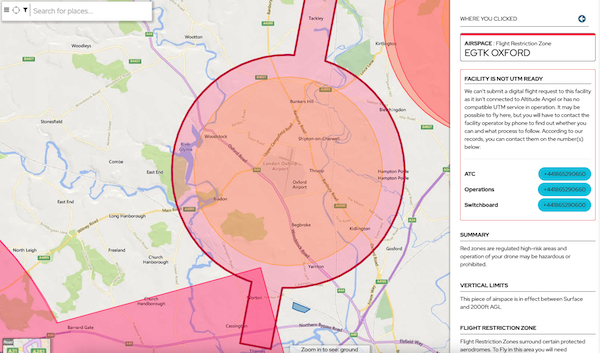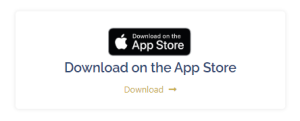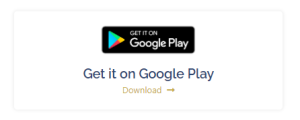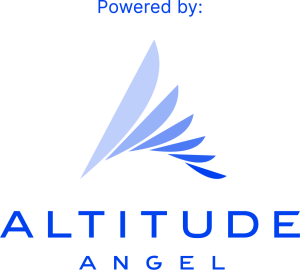
Drones and Small Unmanned Aircraft (SUA)
In the United Kingdom, flights of unmanned aircraft around aerodromes that are designated as ‘protected aerodromes’ are restricted.
Unmanned aircraft of any size must not be flown within the Flight Restriction Zone (FRZ) of a protected aerodrome, without appropriate permission.
London Oxford Airport administers all drone flight requests within its Flight Restriction Zone using Altitude Angel’s suite of technology to manage these requests.
Request permission
All Approvals to operate are made issued in accordance with the Terms & Conditions below
Drone flight requests within London Oxford Airport’s FRZ must be submitted 48 hours in advance to allow us time to assess your request. If you have any urgent requirements that sit outside of these parameters, please submit a flight request, and contact us at +44 (0)1865 290650 during office hours.
The operator must also contact Oxford Air Traffic at least 1 hour prior to launching the drone to obtain ATC Clearance. Please ensure that you have your Mission ID to hand.
To submit a drone flight request, you have the following options.
London Oxford Airport Drone Safety Map by Altitude Angel
Using the Map below, please locate London Oxford Airport, select the London Oxford Airport FRZ and click “Request to Fly here”
For existing Altitude Angel users, this link will take you directly to Altitude Angel’s Operator Portal, where you can submit your mission details for approval to us. If you are not already an Altitude Angel user, then by clicking on the link, you will be presented with the option to register for free and then proceed to your new account to submit your mission details.
Please see User guide to Altitude Angel’s Operator Portal for more information.
Drone Assist Mobile App by Altitude Angel
Region: UK
Drone Assist is the #1 drone safety app from Altitude Angel in the UK. It provides an interactive map of the sky and is used by general aviation, other airspace users, and drone pilots! It is tailored specifically for the UK audience. It allows you to see areas to avoid or in which extreme caution should be exercised and ground hazards that may pose safety, security or privacy risks when flying your drone.
If you are an existing Altitude Angel user, your user credentials can also be used for both the Drone Assist App and Operator Portal, and vice versa.
Once logged into the App, locate London Oxford Airport on the interactive map, and create your mission plan using the in-app technology, which will automatically request approval if the mission plan resides within the London Oxford Airport FRZ.
For more information on the Altitude Angel’s Drone Assist APP, a user guide can be located within the APP or click here to learn more.
The free app is available in the Apple Store and Google Play store.
Terms and Conditions
-
- Approval is issued subject to permission on the day based on the airports operational state. Final approval shall be obtained by the drone operator prior to flight by calling the Duty Air Traffic Controller via telephone on 01865 290650.
- The Operator must be contactable by telephone throughout the flight, please provide a contact number to ATC if it is different to what is detailed on the approval.
- Where the Approval details specific restrictions, these have been put in place to ensure the safety of our operation and must be complied with.
- The flight is to be conducted in accordance with the Air Navigation Order and you are responsible for avoiding all other aircraft at all times.
- Approval for access to airspace is given on the basis of remaining entirely within the limits of the stated lateral and vertical operating area and no safety assurance against other Unusual Air Activities taking place in the same area is given or implied.
- The Operator must maintain direct, unaided visual contact with the drone at all times, sufficient to monitor its flight path in relation to other aircraft, persons, vehicles, vessels and structures for the purpose of avoiding collisions for which you are exclusively responsible and liable for.
- The Operator shall have the Approval and CAA Permission for Commercial Operation (if required) in their possession at all times during flight.
- The Operator/Flight Assistant shall maintain an exclusive telephone line for ATC to contact them in the event of an emergency. The drone must be landed immediately if any incident arises or is likely.
- Operators are required to have drone insurance sufficient to cover all aviation risks that may arise.
- The granting of Approval/Permission does not imply exemption from the requirements of the Air Navigation Order or the Rules of the Air Regulations. Applications for flights which require exemption or written permission under the Air Navigation Order must be made to the Civil Aviation Authority.
- Approvals are not valid if any of the details of the operation change (vertical/lateral limits etc). An updated request should be submitted, and further approval received prior to flight.
- Flights over the Blenheim Estate require further approval from Estate Management.
- Oxford ATC are not always made aware of Helicopters flying into the Blenheim Estate. It is the responsibility of the Drone Operator to liaise with Blenheim Estate Management with regard to restrictions on helicopter operations.
Flight Restriction Zone (FRZ)
You must not fly a SUA within the flight restriction zone of a protected aerodrome without obtaining permission. London Oxford Airport is a protected aerodrome. Diagrams showing the Flight Restricted Zones around London Oxford Airport can be seen in the map on this page.
The flight restriction zone is active at all times (H24) and applies to all small, unmanned aircraft of any mass, even small toys.
Having received approval for your request, during Oxford Air Traffic Control’s hours of operation (06:30-22:30 local times, or as notified by NOTAM) final permission must be obtained from the Air Traffic Control Officer (ATCO) on duty.
Outside ATC hours, permission must be obtained from the aerodrome operator. If permission cannot be obtained the flight may not take place.
The Drone Code
When you fly a drone in the UK, it is your responsibility to be aware of the rules that are in place to keep everyone safe. Follow these simple steps to make sure you are flying safely and legally.
FLYING DRONES SAFELY AND LEGALLY
When you fly a drone in the UK it is your responsibility to be aware of the rules that are in place to keep everyone safe.
Drone Access Policy (UK only):
The drone pilot must be aware of and comply with the law relating to safe and legal operations, this includes:
-
- Air Navigation Order 2016
- CAP722A; and
- The UK Civil Aviation Authority (CAA) Drone Code.
All drone pilots must:
-
- Operate only within the area authorised by the airspace owner
- Make sure that anyone flying under their operator ID is sufficiently competent to undertake the operation safely and legally.
- Make sure that flyers have planned and will carry out flights safely and legally
- Keep any software on the drone or model aircraft up to date, including any information on airspace restrictions.
- Make sure pilots are aware of any airspace restrictions through GuardianUTM such as www.dronesafetymap.com or Drone Assist Apps (iOS and Android).
- In the case of European Class marked drones or model aircraft, make sure the class mark is not removed.
- Apply the appropriate level of experience, skills, and resources to manage safety risks effectively; the more complex or risky a proposed operation is, the more extensive and detailed the planning and oversight of the proposed operations must be.
Actions:
-
- Read the aircraft instruction manual carefully.
- Register as an operator (this is a legal requirement for all drones or model aircraft weighing 250g or over; and for all drones or model aircraft with a camera, apart from toys).
- Label their aircraft with their Operator ID.
- Demonstrate competence through training, either through a valid FlyerID or CAA-approved training course through a UK Recognised Assessment Entity (RAE).
- Look after their aircraft to ensure it is in safe working condition to fly.
- Where required, insure the aircraft or make sure the correct insurance cover is held.
- Carefully decide when and where the aircraft will be flown.
- Carefully decide who may fly their aircraft.
- Ensure the remote pilot is competent to carry out the flight safely and legally.
- Plan your flight carefully to minimise risk and reduce the chance of something going wrong.
REPORTING SAFETY CONCERNS ABOUT DRONES
If you have any concerns about drones being used in vicinity of London Oxford Airport either from a safety or privacy perspective, contact your local police on 101.






